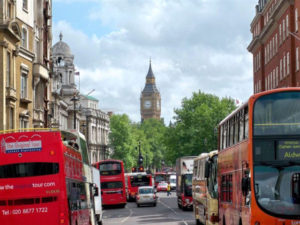Mayor of London Sadiq Khan is to look at measures including road pricing, measures to cut down or retime van and lorry trips and a zero-emission zone in central London in a move to drive down vehicle use and ensure London’s entire transport system is zero emission by 2050.

The mayor’s newly published draft Transport Strategy – which is now out for consultation until 2 October – sets out a target to reduce total London traffic by 10-15% by 2041 as well as plans to reduce overall van and lorry use in central London in the morning peak by 10% by 2026.
Plans include building on the forthcoming introduction of the Ultra Low Emission Zone and the T-charge by looking at latest forms of road user charging, including a pay-per-mile charge to address both congestion and emissions objectives, and a workplace parking levy scheme.
Key elements of the drive to improve air quality would also see a zero emission zone in central London by 2040 and a London-wide zone by 2050 – with public sector fleets expected to stand at the forefront of the shift to ultra-low and zero emission technologies. By 2030, the plans say all public sector car fleet should be zero emission capable. The plans also account for taxis and PHVs, which would be required to be zero emission capable by 2033 with buses to be zero emission by 2037.
Meanwhile on a national scale, the plan calls for vehicle tax exemption for zero-emission vehicles now along with a diesel scrappage scheme in 2020 and taxation to encourage ULEVs over conventional vehicles. And by 2050, the plans say taxation should discourage ownership of non-zero emission vehicles.
The plans would look to target freight by cutting down on or retiming van and lorry trips through better consolidation of freight and servicing activity, including with the use of regional consolidation and distribution centres at the edge of London and micro-distribution centres in inner and central London.
Other road safety measures could include introducing lower speed limits and stricter enforcement of speed limits.
The plans also consider how to accommodate the growing rise of internet shopping, with plans to work with the largest employers in London to find ways of encouraging the re-direction of their staff’s personal deliveries to a network of ‘walk to’ collection points as well as the promotion of ‘click and collect’ services.
The FTA’s Natalie Chapman, head of policy for London, said: “It costs so much to deliver into London that the road freight industry is already highly load efficient. There may be some benefits from further consolidation we can gain, but these will be outweighed by the needs of London’s larger population. The real gains in traffic management will come from private car use – if car users can be enabled or encouraged to switch to public transport, cycling or walking then London’s transport network could become exponentially more efficient.”

